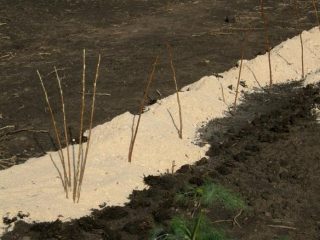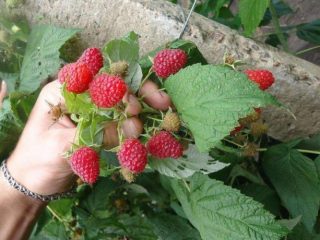Content
Almost everyone who has a garden plot grows raspberries. The bushes are grown to produce tasty and healthy berries. Unfortunately, these are not always varietal plants; the yield does not meet the needs.
It is not necessary to go to the store for seedlings if your neighbor has different varieties of raspberries growing on his property. If you plant one bush, then after a year, when the seedling has formed a good root system, you can get new varietal plants. The question of how to propagate raspberries by cuttings or other methods worries many gardeners. Let's figure out why propagation by parts of a plant is good, and whether the varietal qualities are preserved.
What does it take for breeding to be successful?
In order for raspberry propagation to be successful, the following conditions must be met:
- Planting material is planted in moist, fertile soil.
- Raspberry propagation should be done in cloudy weather; the plantings should be shaded for several days.
- Work is carried out at a temperature not lower than +23 degrees.
They stock up on a shovel, pruning shears, and a sharp knife in advance.
Reproduction methods
The plant manages to use up soil resources (even fertilizing does not help), and the yield decreases. We need to move the raspberry tree to a new place, but there are no seedlings, and they are not cheap. How to be in this case?
You can grow planting material yourself using old plantings. We will talk about raspberry propagation. There are many ways by which you can not only provide yourself with raspberry seedlings, but also preserve the varietal qualities of raspberries.
Raspberry propagation methods:
- lignified offspring:
- green shoots;
- shoots;
- root cuttings;
- dividing the bush;
- layering;
- nettle;
- microclonal method;
- Scottish method.
You can propagate a new plant from seeds. The process is quite lengthy, and besides, there is no certainty that parental qualities will be repeated.
Lignified offspring in autumn
The most common way to obtain planting material is to propagate raspberries by root suckers. They are located at a distance of 30 cm from the mother bush and grow from an adventitious bud during the summer.
In the fall, the shoot is carefully dug up so as not to damage the roots. After this, you need to audit the planting material. If there is swelling or bluish spots on the stem, it cannot be used for propagation.
Green root shoots
When raspberries begin to grow after hibernation, a large number of shoots appear around the bush; they are called green shoots. When they grow to 15-20 cm, they choose the healthiest ones, retreating 40 cm from the bush, and dig them up with a clod of earth.
Root cuttings
One of the common methods is to propagate raspberries by cuttings in the fall or spring. They retreat 40 cm from the mother bush, dig up the soil and take an adventitious root with branches. The root must be at least two millimeters in diameter. When cutting the root (10 cm each), the presence of buds is taken into account. There is no need to cut off the roots.
The cuttings should be immediately placed (flat) in fertile soil in the grooves, sprinkled with earth and watered.
Green cuttings
Throughout the season, gardeners thin out raspberries. There is no need to throw away healthy shoots; this is an excellent material that will allow you to propagate raspberries with green cuttings.
Select shoots up to 15 cm in height and 2-3 leaves. The cut is made close to the ground. You need to work with a sharp, previously disinfected knife. Several cut shoots are tied into a bundle. To help the cuttings quickly form roots, they are soaked in a Heteroauxin solution for 17 hours. After this, they are planted in a greenhouse or garden bed for growing.
Dividing the bush
There are valuable raspberry bushes that I want to propagate, but few root shoots are produced. In this case, it is recommended to propagate raspberries by roots. When dividing the bush, the planting material must have healthy roots and at least two shoots.
Propagation by nettles
If you have only one bush of a valuable raspberry variety, but you want there to be several of them on your site, use a small shoot of nettle. Propagation of raspberries by nettles is a unique version of cuttings.The shoots should not be higher than 15 cm. They are cut off and immediately planted in the ground. The work is done in the evening. Can be timed for rainy weather. Planting material needs abundant watering and shading in the first days. This promotes rapid root growth.
How to propagate raspberries, video:
Method from Scotland
If you need to propagate remontant raspberry varieties, use the Scottish method. It is based on plant propagation by roots. They are harvested in the fall and planted in the spring. The roots need to be dug up, cut into 15 cm pieces, and treated in a solution of potassium permanganate.
Store planting material in boxes in moss. For the winter they put it in the refrigerator or cellar. Sprinkle lightly with water from time to time.
In early spring, sprinkle the roots with soil or peat and water generously. When the leaves appear, the shoots are separated along with the upper part of the root and transplanted into a greenhouse in the shade, under polyethylene. If there is no greenhouse, you can plant in pots, covering the plantings with a bag.
Young plants take root after 20 days. The cover is removed after 35 days. Planting in the ground with the arrival of warm days in early June. Each bush is covered with a plastic bottle.
The Scottish method of propagating raspberries completely preserves the parental qualities. It is widely used by the people of Scotland.
Rarely used methods
Growing from seeds
Propagation of raspberries by seeds is rarely used at home, due to the labor-intensive process. Seeds are collected from ripe berries. You can sow them in the spring, but experienced gardeners recommend doing everything at once.
Seeds need stratification, which will promote better germination.They are sown in a nutrient substrate to a depth of no more than 2 cm and sprinkled with sand. Sprouts will appear in the spring. Raspberry shoots are fed and watered. Replant to a permanent location in the fall.
Method for scientists
Microclonal propagation of raspberries is carried out in laboratory conditions. To obtain a new plant, a piece of plant tissue is used; the raspberry is grown in a test tube. Look at the photo below, it's really interesting!
Useful tips
Common and remontant raspberry in different ways, but success will depend on following certain rules. Experienced gardeners advise:
- The seedlings are planted in moist nutrient soil.
- Use only healthy raspberry bushes for propagation.
- If the seedlings were grown indoors or in a greenhouse, harden them off before planting in open ground.
We hope that the material is interesting for gardeners. Choose any method to propagate raspberries and grow healthy bushes with delicious berries.
















